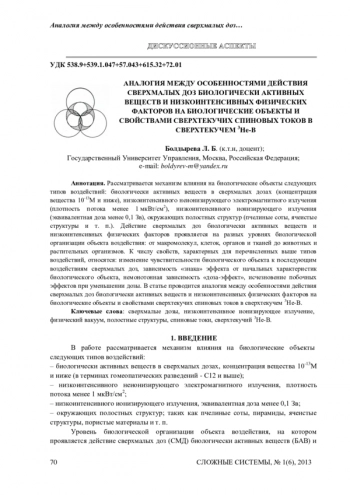Рассматривается механизм влияния на биологические объекты следующих типов воздействий: биологически активных веществ в сверхмалых дозах (концентрация вещества 10-13М и ниже), низкоинтенсивного неионизирующего электромагнитного излучения (плотность потока менее 1 мкВт/см2), низкоинтенсивного ионизирующего излучения (эквивалентная доза менее 0,1 Зв), окружающих полостных структур (пчелиные соты, ячеистые структуры и т. п.). Действие сверхмалых доз биологически активных веществ и низкоинтенсивных физических факторов проявляется на разных уровнях биологической организации объекта воздействия: от макромолекул, клеток, органов и тканей до животных и растительных организмов. К числу свойств, характерных для перечисленных выше типов воздействий, относятся: изменение чувствительности биологического объекта к последующим воздействиям сверхмалых доз, зависимость «знака» эффекта от начальных характеристик биологического объекта, немонотонная зависимость «доза-эффект», исчезновение побочных эффектов при уменьшении дозы. В статье проводится аналогия между особенностями действия сверхмалых доз биологически активных веществ и низкоинтенсивных физических факторов на биологические объекты и свойствами сверхтекучих спиновых токов в сверхтекучем 3Не-В.
The work is concerned with the mechanism of effects of the following physical factors on biological objects: biologically active substances in ultra-low doses (the substance concentration is 10-13М or lower), the low-intensity non-ionizing electromagnetic radiation (the flux density is less than 1 μW/cm2), the low-intensity ionizing radiation (the equivalent dose is less than 0.1 Sv), the ambient cavity structures (bee combs, pyramids, meshy structures, porous materials, and others). The levels of biological organization of target biological objects at which the action of ultra-low doses of biologically active substances and low-intensity physical fields is revealed are quite various: from macromolecules, cells, organs, tissues to plants and animals.
Among the properties characteristic of the above types of effects there are the following: a change in sensitivity of the biological object with respect to a subsequent exposure to a ultra-low dose, dependence of the ‘sign’ of the effect on the initial state of the biological object being treated, a non-monotonic ‘dose-effect’ dependence, disappearance of side effects with a decreased dose of BAS (but with persisting activity of the BAS in ULD).
The paper draws an analogy between the effects of ultra low doses of biologically active substances and low-intensity physical factors on biological objects and the properties of spin supercurrents in superfluid 3He-B.





